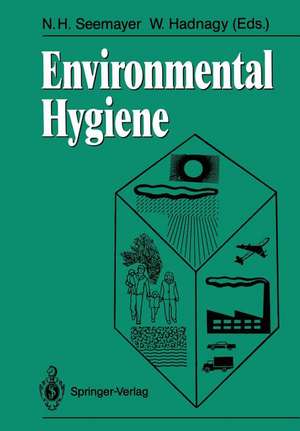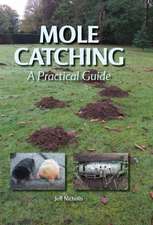Environmental Hygiene
Editat de Norbert H. Seemayer, Wolfgang Hadnagyen Limba Engleză Paperback – 6 dec 2011
Preț: 943.07 lei
Preț vechi: 1150.09 lei
-18% Nou
Puncte Express: 1415
Preț estimativ în valută:
180.46€ • 189.04$ • 149.56£
180.46€ • 189.04$ • 149.56£
Carte tipărită la comandă
Livrare economică 09-23 aprilie
Preluare comenzi: 021 569.72.76
Specificații
ISBN-13: 9783642737688
ISBN-10: 3642737684
Pagini: 232
Ilustrații: XIV, 214 p.
Dimensiuni: 170 x 244 x 12 mm
Greutate: 0.38 kg
Ediția:Softcover reprint of the original 1st ed. 1988
Editura: Springer Berlin, Heidelberg
Colecția Springer
Locul publicării:Berlin, Heidelberg, Germany
ISBN-10: 3642737684
Pagini: 232
Ilustrații: XIV, 214 p.
Dimensiuni: 170 x 244 x 12 mm
Greutate: 0.38 kg
Ediția:Softcover reprint of the original 1st ed. 1988
Editura: Springer Berlin, Heidelberg
Colecția Springer
Locul publicării:Berlin, Heidelberg, Germany
Public țintă
ResearchCuprins
General Aspects of Environmental Pollution.- I. In Vitro Tests.- 1. Cytotoxicity and Genotoxicity on Mammalian Cells.- Mechanisms of O3 and NO2 toxicity in lung cells in vitro.- A study on the biological effects of power station ash.- Induction of malignant transformation in hamster fetal cells (HFC) by diverse environmental carcinogens.- Biochemical and morphological studies on ozone and nitrogen dioxide treated cultured lung cells.- Induction of sister chromatid exchanges by asbestos fibres in combination with other mutagens studied in Chinese hamster cells in vitro.- Evaluation of genotoxic effects by environmental pollutants using cell culture systems.- Metabolic activation and cytotoxicity of airborne particulate matter.- Mutagens in surface and waste water.- Effects of benzene and other lysosomotropic agents on ultraviolet light induced photolysis of lysosomes in Herpesvirus infected cells.- Toxic and genotoxic effects of SO2 or NOX alone and in combination with carcinogenic N-nitrosamines.- Target organ cells as in vitro test systems for toxicity, mutagenicity, DNA-repair and transformation by environmental pollutants.- Indicators of potential health risks by airborne particulates: Cytotoxic, mutagenic and carcinogenic effects on mammalian cells in vitro.- 2. Cytotoxicity and Genotoxicity on Bacterial Cells.- Thiaarenes — their environmental occurrence and biological activity.- Heavy metals and polyaromatic compounds in suspended particulates of different emission sources and their mutagenicity.- Microbicidal effects of exhaust gases and their secondary products under field conditions.- 3.Specific Effects on Cell Functions.- Tumor promoter PMA and crosslinking of surface immunoglobulins induce superoxide production in Epstein-Barr-Virus-infected human Blymphocytes: a novel pathway for the production of potentially mutagenic species.- Strong effects of cytokines from quartz dust exposed human mononuclear cells on human mesenchymal cells and polymorphonuclear leukocytes.- In vitro effects of environmental pollutants on mediator release.- Alterations of chick embryo yolk sac blood vessels after application of environmental pollutants.- Use of bovine alveolar macrophages and of their lysosomes for in vitro studies with mineral dusts.- Neurotoxicology of heavy metals: Synaptic transmission as influenced by mono- and divalent metalcations.- II. Animal Models.- Effect of some metal ions (Cd++, Pb++, Mn++) on mediator release from mast cells in vivo and in vitro.- Investigations of the lung carcinogenic potentials of sodium dichromate and Cr Vl/lll oxide aerosols in Wistar rats.- Lung tumor risk estimates of inhaled cadmium.- Toxicity and carcinogenic risk after long-term inhalation of Cd-compounds in Wistar-rats.- Postnatal mouse heart and lung lysosome RNAase levels in response to air pollutants.- III. Biological Monitoring.- Formic-acid excretion in urine as a biological-monitoring-parameter in areas with different air pollution.- Exposure to cadmium of the West-German population.- Evaluation of alveolar burden of mineral fibres in cases of occupational and non occupational exposure to asbestos.- Changes of biochemical parameters following short-term exposure to aircraft-noise.- Deposition and short-term clearance of aerosol particles in the human respiratory tract.- Factors influencing cadmium and lead concentrations in hair of children.- IV. Epidemiology.- Cytogenetic findings in styrene workers in relation to exposure.- Influence of air pollution to to respiratory diseases in infancy.- Toxicopy — a basic mechanism tocope with environmental threats.- Odour caused mass illness around a plant producing quartz and feldspar by flotation.- Growth and bone maturation of children living in areas with different degrees of air pollution: A repeated study.- Chromosome aberrations in peripheral lymphocytes of persons present in the vicinity of Chernobyl during and after the reactor accident.- Dispositions prophylaxis for children from air polluted areas.- V. Environmental Control and Legislation.- Source apportionment of heavy metals in air particulate matter using automated electron probe micro analysis.- New aspects to define air quality guidelines for carcinogenic substances in the Federal Republic of Germany.- Principles and methods for control of air pollution in health resorts.- On the emission of fibrous particles from corroded asbestoscement products.- Environmental and health control — role of metal resistance in bacteria.















